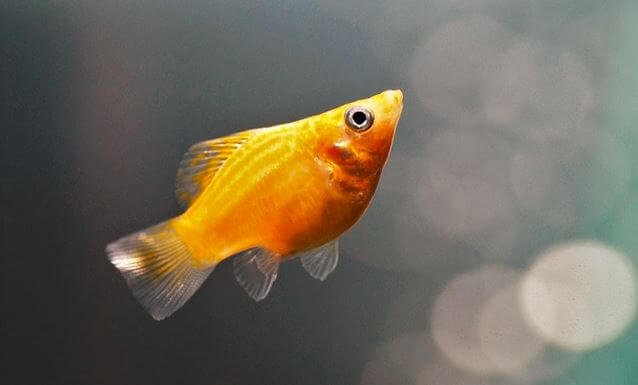When your molly fish starts shaking, it’s time to take notice! Whether small or large tremors, shaking indicates that something is amiss with your pet fish. As a new molly parent, such an occurrence will trigger the question, “Why is my molly fish shaking?”
Your molly fish is shaking because of stress due to poor water chemistry and infections. Moreover, incorrect temperature and anxiety can trigger profuse trembling. You can remedy the shaking by maintaining the correct water chemistry, hygiene, and temperature.
In this article, I’ll discuss the five causes of molly fish shaking. I’ll also elaborate on how to remedy these issues for a happy, healthy molly fish. Keep reading!
Why Is My Molly Fish Shaking? 5 Causes and Their Solutions

Shaking in mollies happens for many reasons. As a keen aquarist, you want to understand the exact cause of this strange behavior in your molly fish.
Here are the five main reasons your molly fish is shaking:
1. Poor Water Chemistry
Your fish’s resilience might not last longer if the aquarium water has impurities.
Although mollies are known to be resilient aquarium fish, they won’t hold on longer if the water chemistry deteriorates excessively—they’ll eventually start shaking.
Some conditions that trigger the shaking response include:
- Low water pH: Your molly fish will experience skin burn due to high acidity if the water pH is below 7. Skin burn causes irritation, hence the shaking behavior.
- Ammonia and nitrites: Any fish expert will tell you that ammonia is a harmful gas to fish. Similarly, nitrites are highly poisonous since they make oxygen circulation in the fish’s bloodstream inefficient. An aquarium with even the slightest amount of these substances will trigger stress and shaking of the fish.
- High nitrates: Although nitrates are not toxic as ammonia and nitrites, they contribute to algae growth in the aquarium. Excessive algae can become a severe problem that leads to stress in your mollies.
Your fish will suffer if you don’t maintain proper water chemistry, especially by disregarding the abovementioned three elements. The change will impact your molly fish negatively once the concentration of even the mildest substance increases.
Find Out: How Many Mollies Should Be Kept Together? 6 Important Factors to Consider
Solution
Maintain conducive water chemistry to ensure no impurities in the tank. Therefore, you should clean the tank regularly to remove excess leftovers that can rot and produce ammonia.
A rule of thumb is to maintain the following parameters for a safe aquarium:
- A pH between 6.7-8.5
- Temperature of 72 to 78℉ (22.22 to 25.56℃)
- 6 to 12 dGH water hardness
It’s worth noting that regular weekly water changes are vital for the best aquarium tank conditions. A regular 25% weekly water change will help maintain the abovementioned tank conditions.
2. Soft or Less Hardy Water
Always left untouched by millions of aquarists, incorrect water hardness could become the greatest undoing for your once-a-happy wet pet.
Keeping water hardness outside the recommended range (6-12 dGH/100-200 ppm) can result in stress and shaking in your molly fish.
Naturally, mollies thrive in moderately hard water for the efficient functioning of their metabolic and physiological processes. Otherwise, the fish could use plenty of energy to maintain these functions.
The table below shows some water hardness conditions in which your molly fish will start shaking:
| Water Hardness | Molly Fish Tolerance |
| Very soft water (0-3 dGH/0-50 ppm) | Molly fish will be uncomfortable. Such hardness creates anxiety in molly fish because it deprives them of essential nutrients like magnesium and calcium for efficient molly fish growth. |
| Soft water (3-6 dGH/50-100 ppm) | Still, magnesium and calcium are insufficient to support a molly fish’s minimum needs. |
| Slightly harder water (12-18 dGH/200-300 ppm) | While mollies can generally persevere in slightly harder water, leaving them there is not always a good idea. They’ll eventually get stressed and start shaking. |
| Very hard water (18+ dGH/300+ ppm) | Such water has excess minerals, which can again harm your molly fish. It’s one of the major causes of shaking in molly fish that you should work to correct. |
Solution
Maintain a water hardness of 6-15 dGH to allow normal growth and functions of your molly fish.
You can increase water hardness for your molly’s safety in the following ways:
- Using treated and balanced hard tap water
- Adding crushed coral minerals to the tank
- Adding Epsom salt to the tank
Suppose the water hardness is higher; you can adjust it through a reverse osmosis deionization system and other methods like adding aquarium soil or driftwood to the water to help reduce hardness.
3. Infections
The other cause of molly fish shaking that many aquarists would immediately guess is disease or infection.
Of course, bacterial, fungal, and parasitic invasions could irritate, weaken, and disrupt your fish’s physiological processes, leading to discomfort and trembling.
In the event of infections like ich (caused by the parasite Ichthyophthirius multifiliis) that makes a molly scratch against objects in the tank could cause shaking. Velvet disease can also lead to molly fish tremors and shaking.
Dropsy and fin rot diseases makes the fish uncomfortable, contributing to the shaking behavior. This is usually common in the later stage of the disease.
Solution
First, ensure you seek veterinary support for urgent cases. The vet will help diagnose and figure out the best treatment course.
Otherwise, treat dropsy and other diseases by adding Epsom salt and suitable broad-spectrum antibiotics for bacteria and fungi.
The vet will prescribe suitable anti-parasitic medications for conditions like ich.
Finally, it’s essential to observe quarantine measures by separating the sick fish from the rest. Quarantining prevents the spread of the disease to other fish.
Find Out: Why Is My Molly So Fat? 4 Main Reasons and Their Remedies
4. Low Temperature
Central to your molly fish’s welfare is the correct water temperature.
As much as these fish can survive in a wide range of temperatures, extremely low temperatures causes shimmies. This is because cold temperatures slow down their metabolism and physiological processes.
The result is a shivering fish instead of roaming the water and enjoying a good meal. If, for example, you introduce your molly to a tank with cold water, expect it to shake due to a thermal shock.
Solution
Molly fish are tropical fish that enjoy a wide range of temperatures. Therefore, maintain temperatures between 72-78℉ (22.22-25.56℃).
You can use commercial heaters to raise the aquarium water temperature if it’s too low.
5. Stress and Shock
Constant stress and anxiety in molly fish is a solid trigger for shimmies.
What happens is that your molly fish’s immune system weakens, straining the central nervous system. Once this happens, the fish starts swimming frantically, rubbing itself on gravel and rocks and crashing at the bottom of the tank. These bombardments result in shaking.
Moreover, a fish under severe stress and shock loses its coordination abilities. As a result, it starts trembling due to a broken-down nervous system.
Solution
Reduce stressors and shock triggers. For instance, decongest your tank and remove any bullies among mollies.
In addition to the five causes of uncontrolled molly fish shaking, your molly could also shake due to contaminated water, aggressive tank mates, and poor nutrition resulting in weak immunity.
What Is Molly Fish Shaking?

Molly fish shaking is a condition that occurs when mollies exhibit excessive trembling under severe stress.
Stress in molly fish is mainly caused by the following:
- Aggressive tank mates that keep bullying and fighting other fish
- Anxiety and shock due to unnatural occurrences in the tank. It could be some unfamiliar noise that shocks the fish into trembling
- Low temperatures reduce molly fish activity as far as swimming and roaming are concerned.
- A poor diet affects the fish’s immunity, rendering it weak and vulnerable to various diseases
- Infections
- Unsuitable water hardness. Molly fish need moderate hardness – not too low or too high for survival
- Unsuitable water conditions with nitrites and ammonia
How to Identify Molly Fish Shaking
You can identify molly fish shaking by observing rapid body movements. Your molly fish is likely having shimmies if its body is vibrating rapidly.
These back-and-forth body movements indicate an underlying health problem if they keep occurring.
Here are more signs of molly fish shaking:
- Fish quiver as they swim
- Fish show erratic swimming patterns
- The fish has poor appetite
- The fish becomes restless due to irritation
- Fins get clamped and are held closer to the body.
- Loss of balance during swimming
- Fish has less vibrant colors because of poor eating
It’s vital to be proactive about molly fish shaking and take necessary measures before your fish gets into this problem. You can achieve that by maintaining the right water chemistry and cleaning the tank regularly.
How to Prevent Molly Fish Shaking
Here are the ways to prevent molly fish shaking:
- Install a high-quality filtration system to keep the aquarium water clean, fresh, and well-oxygenated
- Ensure that the aquarium has the correct number of fish—don’t keep many fish in an aquarium to avoid overcrowding and stress.
- Provide a highly nutritious diet with high-quality pellet or flake food specific for mollies. The diet should be low on calories. Furthermore, include fresh vegetables like squash, zucchini, and lettuce.
- Install hiding spots in the aquarium to create a sense of security for the fish when stressed.
- Minimize factors that cause stress in the tank. For instance, avoid sudden changes in water temperatures. Moreover, minimize external noise to reduce anxiety.
Final Thoughts
The question, “Why is my molly fish shaking?” is commonplace among many responsible aquarists.
It’s your responsibility to know why your pet fish is shaking and what to do to alleviate the problem.
Molly fish tremors serve as an indicator of their well-being and the aquarium environment.
After unraveling the five key reasons for your molly fish shaking, take the necessary steps to remedy the situation and restore your fish’s health. A rule of thumb is to maintain stable tank conditions and regular monitoring.

